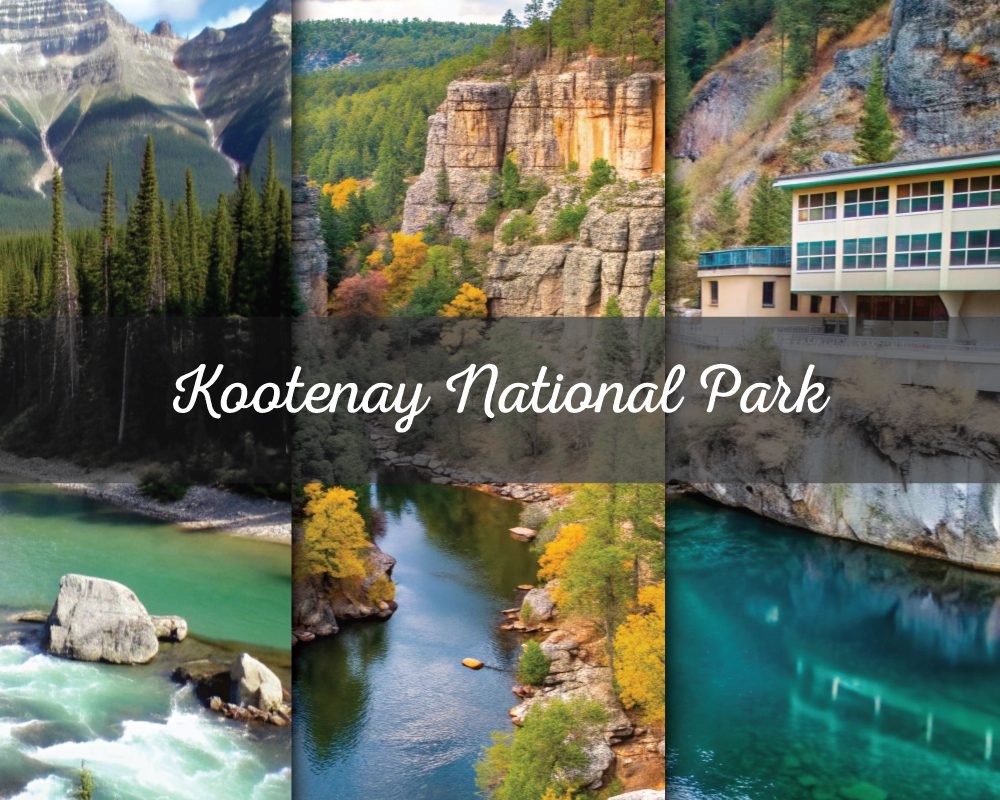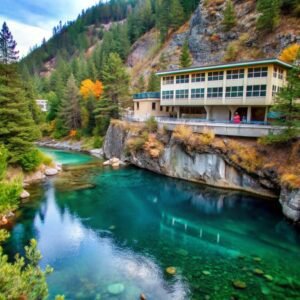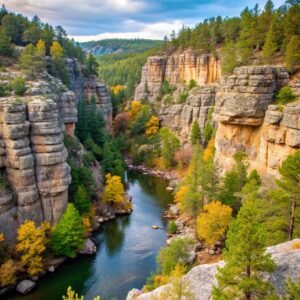
Table of Contents
Introduction:
Nestled in the majestic Canadian Rockies of British Columbia, Kootenay National Park unfolds like a living canvas of untamed wilderness. As the gateway to the stunning landscapes of the Canadian Rocky Mountain Parks World Heritage Site, Kootenay National Park beckons adventurers with its diverse ecosystems, glacial peaks, and a tapestry of flora and fauna. In this exploration, we will delve into the geological wonders, biodiversity, and recreational treasures that make Kootenay National Park a testament to the natural splendor of British Columbia.
Geological Marvels: The Backbone of Kootenay
Kootenay National Park is a geological masterpiece, shaped by ancient forces that have left an indelible mark on its landscapes. The park showcases the transition from the impressive Rocky Mountains to the foothills, creating a mosaic of terrain that captivates every visitor.
- Marble Canyon: Embark on a journey through time at Marble Canyon, where the Kootenay River has carved its way through limestone, exposing captivating rock formations. A walk across the canyon’s bridges offers views into the depths of geological history.
- Paint Pots: Unearth the vivid hues of ochre at the Paint Pots, a natural phenomenon where iron-rich mineral springs create vibrant pools of color. The short hike to this geological wonder provides a visual spectacle amidst the mountainous surroundings.

Biodiversity: A Haven for Flora and Fauna
ootenay National Park is a sanctuary for a rich array of plant and animal life, thriving in its diverse ecosystems. From alpine meadows to dense forests, the park provides a habitat for species adapted to the challenges of mountain living.
- Sinclair Canyon: Explore Sinclair Canyon for a glimpse into the park’s biodiversity. The canyon’s varied habitats host a range of bird species, including the iconic mountain bluebird, making it a birdwatcher’s delight.
- Ochre Beds Trail: Traverse the Ochre Beds Trail to witness the park’s unique plant life, from delicate wildflowers to hardy alpine vegetation. The trail’s interpretive signs offer insights into the flora that graces Kootenay’s landscapes.

Outdoor Adventures: From Hiking to Hot Springs
Kootenay National Park is a playground for outdoor enthusiasts, offering a myriad of activities that showcase the park’s natural wonders. Whether seeking challenging hikes or moments of relaxation, the park caters to a range of interests.
- Stanley Glacier Trail: Embark on the Stanley Glacier Trail for a rewarding hike through alpine meadows and alongside a glacial moraine. The trail culminates in views of the expansive Stanley Glacier, showcasing the park’s rugged beauty.
- Radium Hot Springs: Unwind in the nearby town of Radium Hot Springs, known for its soothing hot springs. A dip in the mineral-rich waters provides the perfect contrast to the park’s outdoor adventures.

The Vermilion River: A Lifeline Through Kootenay
The Vermilion River courses through Kootenay National Park, shaping its valleys and providing a lifeline for the diverse ecosystems within. The river, surrounded by dense forests and mountainous terrain, offers opportunities for scenic drives and moments of serenity.
- Kootenay Valley Viewpoint: Take in the panoramic views of the Vermilion River and Kootenay Valley from designated viewpoints along the scenic drive. The winding road reveals the park’s stunning landscapes, inviting travelers to pause and absorb the natural beauty.
Trip Plan for Kootenay National Park
Day 1: Geological Marvels and Alpine Adventures
Morning: Arrival and Marble Canyon Exploration
- Arrive in Kootenay National Park and check into your chosen accommodation.
- Begin your exploration with a visit to Marble Canyon. Take a leisurely walk across the bridges and marvel at the geological formations.
Afternoon: Paint Pots and Ochre Beds Trail
- Head to the Paint Pots area and embark on the short hike to witness the vibrant colors created by mineral springs.
- Continue your exploration with the Ochre Beds Trail, immersing yourself in the unique plant life of Kootenay.
Evening: Sunset Views at Kootenay Valley Viewpoint
- Drive to the Kootenay Valley Viewpoint to witness the sunset casting a warm glow over the Vermilion River.
- Return to your accommodation for a relaxing evening.
Day 2: Alpine Hikes and Relaxation in Radium Hot Springs
Morning: Stanley Glacier Trail
- Start your day with a hike on the Stanley Glacier Trail. Enjoy the alpine meadows and panoramic views of the Stanley Glacier.
- Take your time to absorb the pristine beauty of the surrounding landscapes.
Afternoon: Radium Hot Springs
- Drive to Radium Hot Springs for a relaxing afternoon. Soak in the mineral-rich waters and unwind amidst the scenic surroundings.
- Enjoy a leisurely lunch in the town of Radium Hot Springs.
Evening: Riverside Relaxation
- Return to Kootenay National Park and find a peaceful spot along the Vermilion River.
- Enjoy a quiet evening by the river, perhaps with a picnic dinner, and reflect on the day’s adventures.
Day 3: Scenic Drives and Departure
Morning: Kootenay Valley Scenic Drive
- Take a scenic drive through the Kootenay Valley, stopping at viewpoints to capture the breathtaking scenery.
- Visit any spots you may have missed, including additional viewpoints or short trails.
Afternoon: Wildlife Spotting and Farewell
- Spend the afternoon exploring Sinclair Canyon, keeping an eye out for wildlife and bird species.
- If time allows, visit any specific areas of interest you haven’t explored yet.
Evening: Farewell to Kootenay National Park
- Bid farewell to the beauty of Kootenay National Park.
- Depart with memories of geological wonders, alpine adventures, and the serene landscapes of this Canadian Rockies gem.
Conclusion: Preserving the Legacy of Kootenay National Park
Kootenay National Park, with its geological wonders, biodiversity, and outdoor adventures, stands as a testament to the commitment to preserving the natural legacy of British Columbia. Whether exploring the depths of Marble Canyon, hiking to glacier vistas, or relaxing in hot springs, every corner of the park tells a story of resilience and natural beauty.
As visitors traverse the trails, witness the diverse ecosystems, and absorb the grandeur of the Canadian Rockies, Kootenay National Park invites a deep connection with the untamed wilderness. In preserving this sanctuary, we ensure that future generations can continue to marvel at the splendor that defines Kootenay National Park in the heart of British Columbia.
Support Us with Crypto!
If you enjoy our content and want to help keep this site running, you can support us with crypto.
Your support is appreciated!

Tron Network: USDT (TRC20)
Popular hotels near Kootenay National Park
Also read our recent blog – Yoho National Park: A Symphony of Alpine Splendor in British Columbia 2024
Where is Kootenay National Park located?
Kootenay National Park is located in the Canadian Rockies of British Columbia, Canada. It is part of the Canadian Rocky Mountain Parks World Heritage Site, along with Banff, Jasper, and Yoho National Parks.
How do I get to Kootenay National Park?
The main access points to Kootenay National Park are from the east via Highway 93 (Kootenay Highway) and from the west via Highway 1 (Trans-Canada Highway). The park is easily accessible by car, and the nearest airports are Calgary International Airport and Cranbrook International Airport.
What are the must-see attractions in Kootenay National Park?
Some key attractions in Kootenay National Park include:
Marble Canyon: Known for its impressive limestone formations and scenic bridges.
Paint Pots: Vibrant mineral springs that create colorful pools.
Stanley Glacier Trail: A rewarding hike offering views of alpine meadows and the Stanley Glacier.
Radium Hot Springs: Relaxing hot springs located near the park’s western boundary.
Are there camping facilities in Kootenay National Park?
Yes, Kootenay National Park offers camping facilities. There are several campgrounds, including Redstreak Campground near Radium Hot Springs and McLeod Meadows and Marble Canyon campgrounds within the park. Reservations are recommended, especially during peak seasons.
When is the best time to visit Kootenay National Park?
The best time to visit Kootenay National Park depends on personal preferences. Summer (June to August) offers pleasant weather and access to hiking trails. Fall (September to October) brings vibrant foliage. Some facilities may close in winter (November to April), but winter activities such as snowshoeing can be enjoyed.
Are there entrance fees for Kootenay National Park?
Yes, there are entrance fees for Kootenay National Park. Fees vary depending on the type of entry (day pass, annual pass, etc.). It’s recommended to check the official Parks Canada website for the latest fee information.
Are there guided tours or interpretive programs in Kootenay National Park?
Kootenay National Park offers interpretive programs, guided hikes, and special events during the summer months. Check with the park’s visitor centers for the schedule and availability.